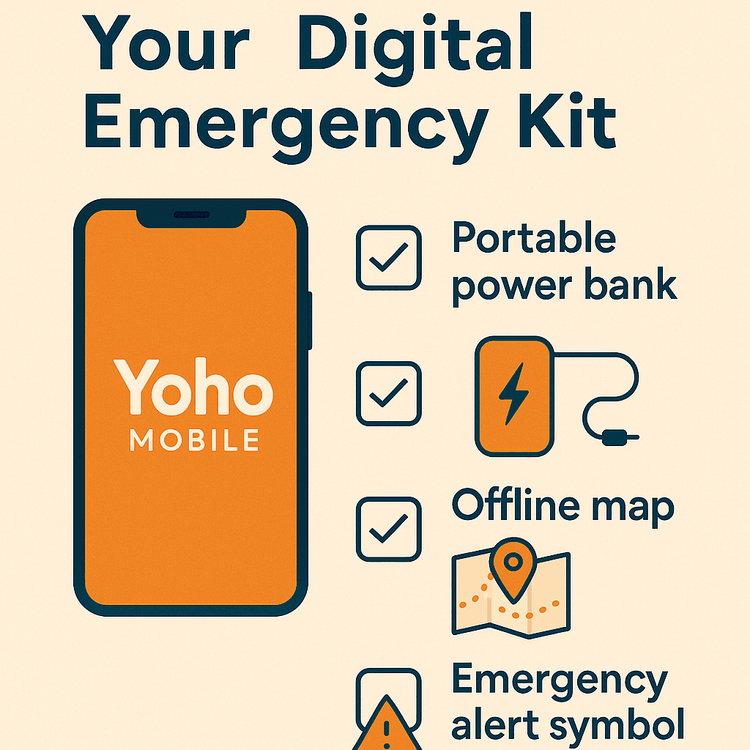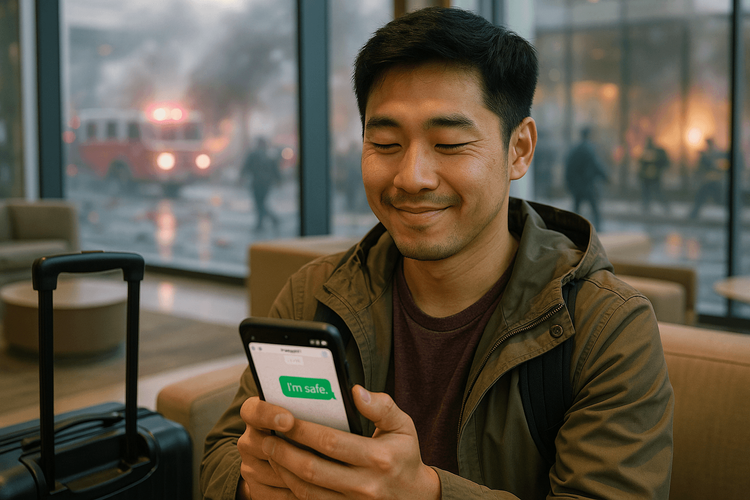When you’re exploring a new country, the last thing on your mind is a natural disaster. Yet, from earthquakes in Japan to typhoons in Southeast Asia, unexpected events can happen. In those critical moments, communication isn’t just a convenience—it’s a lifeline. A well-prepared emergency communication plan is the most important item you can pack, ensuring you can reach loved ones and access vital information when you need it most.
Staying connected is the cornerstone of any safety plan. That’s why having a reliable data solution like a Yoho Mobile eSIM is your first step towards peace of mind. Before you even pack your bags, make sure your connectivity is sorted. Why not start with our risk-free eSIM trial to see how easy it is?
Why a Communication Plan is Non-Negotiable for Travelers
Imagine being caught in an earthquake. Local cell towers become overloaded, power grids fail, and Wi-Fi is a distant memory. This isn’t a scene from a movie; it’s a reality that travelers can face. According to the International Federation of Red Cross and Red Crescent Societies (IFRC), effective communication is critical for disaster response. Without a plan, panic can set in, making a difficult situation far worse.
A solid plan helps you bypass the chaos. It establishes clear steps for how you’ll contact family, what you’ll do if separated from your travel companions, and how you’ll receive official updates from local authorities. This is where modern solutions like eSIMs become invaluable. Unlike a local SIM that ties you to one provider, an eSIM allows you to switch between network partners, significantly increasing your chances of finding a working signal.
Building Your 4-Step Emergency Communication Checklist
Creating a plan doesn’t have to be complicated. Focus on these four essential steps to build a robust communication strategy for any trip.
1. Designate Emergency Contacts
Identify at least two reliable contacts.
- Primary Local Contact: A friend, family member, or colleague in your home country who can act as a central point of communication.
- Secondary Out-of-Country Contact: Someone in a different country or region who is less likely to be affected by the same regional event.
Share your plan with them, and make sure they have copies of your passport, travel itinerary, and insurance details.
2. Establish a Communication Hub
Decide on a single place where you will post updates. This prevents your family from having to frantically check multiple apps. Good options include:
- A private Facebook group or a WhatsApp/Telegram group chat.
- Your primary contact’s social media page.
- The American Red Cross’s Safe and Well website.
Agree on a check-in schedule (e.g., every 3 hours) so your contacts know when to expect an update. This reduces anxiety for everyone involved.
3. Prepare Your Digital Toolkit
Your smartphone is your most powerful tool, but it’s only as good as its preparation. Your digital toolkit should include:

- Reliable Connectivity: A Yoho Mobile eSIM is crucial. With our plans, you’re not locked into a single local network. Better yet, with Yoho Care, you’re never truly disconnected. Even if your main data package runs out during an emergency, Yoho Care provides a backup connection to ensure you can send that crucial “I’m safe” message.
- Offline Resources: Download offline maps of your destination on Google Maps or
Maps.meSave screenshots of your hotel address and key phone numbers. - Emergency Apps: Install apps from organizations like FEMA (for US travel) or your destination’s official disaster alert app.
- Power Source: A fully charged power bank is non-negotiable. Aim for one with at least 10,000mAh capacity.
4. Share Your Itinerary & Documents
Before you leave, email your full itinerary—including flight numbers, hotel confirmations, and planned daily activities—to your emergency contacts. Store digital copies in a secure cloud service like Google Drive or Dropbox. This gives your contacts a starting point for locating you if you’re unreachable.
The Role of an eSIM in Natural Disaster Connectivity
In an emergency, flexibility is key. When a natural disaster strikes, some cellular networks may go down while others remain operational. If you’re relying on a single physical SIM card, you’re out of luck if its network fails. This is the critical advantage of an eSIM.
A Yoho Mobile eSIM gives you access to multiple network providers in a single destination. If your phone can’t connect to one, you can manually switch to another from your settings, dramatically improving your odds of staying online. This functionality is a core part of ensuring reliable natural disaster connectivity.
Planning a trip to a region like the Pacific Ring of Fire? Ensure your communication is failsafe. Explore Yoho Mobile’s eSIM plans for Japan or the USA and travel with the confidence that you have a backup. Just make sure your device is compatible by checking our regularly updated eSIM compatible devices list.

Frequently Asked Questions (FAQ)
How can I stay connected during a natural disaster abroad if local networks are down?
If primary local networks are congested or damaged, an eSIM is your best bet as it allows you to switch to other available network partners. Also, seek out public places like evacuation centers, hotels, or government buildings that may have established emergency Wi-Fi hotspots. As a last resort, having a satellite messaging device for true off-grid communication is an option for serious adventurers.
What’s the best eSIM for emergency travel situations?
The best eSIM for emergencies is one that offers broad network coverage and features designed for reliability. Yoho Mobile provides access to multiple top-tier networks in each country. Furthermore, our exclusive Yoho Care service ensures you have a backup data connection even after your plan expires, which is invaluable in an unpredictable situation.
What should be in my travel emergency kit for communication?
Your communication-focused emergency kit should contain both digital and physical items. This includes a fully charged power bank, a pre-installed eSIM on your phone, a downloaded list of emergency contacts and local authority numbers (e.g., embassy, police), and offline maps. A small, battery-powered or hand-crank radio can also be useful for receiving public broadcasts.
How do I create a family emergency communication plan for international travel?
Start by designating primary and secondary contacts who are not traveling with you. Set up a centralized communication hub, like a private WhatsApp group. Share your detailed itinerary with these contacts. Finally, ensure every traveling family member has a reliable connectivity solution, like a Yoho Mobile eSIM, and knows how to use it.
Conclusion: Stay Prepared, Stay Connected
Traveling exposes us to incredible experiences, but it also carries inherent risks. While we can’t prevent natural disasters, we can control our preparedness. Creating an emergency communication plan is a simple, proactive step that can make all the difference in a crisis. By outlining your contacts, preparing your digital toolkit, and securing a versatile connectivity solution, you transform uncertainty into empowerment.
Don’t leave your safety to chance. A reliable connection is your most powerful tool for navigating the unexpected. Explore Yoho Mobile’s flexible eSIM plans today and travel the world with the ultimate peace of mind, knowing you’re always just a click away from safety.
